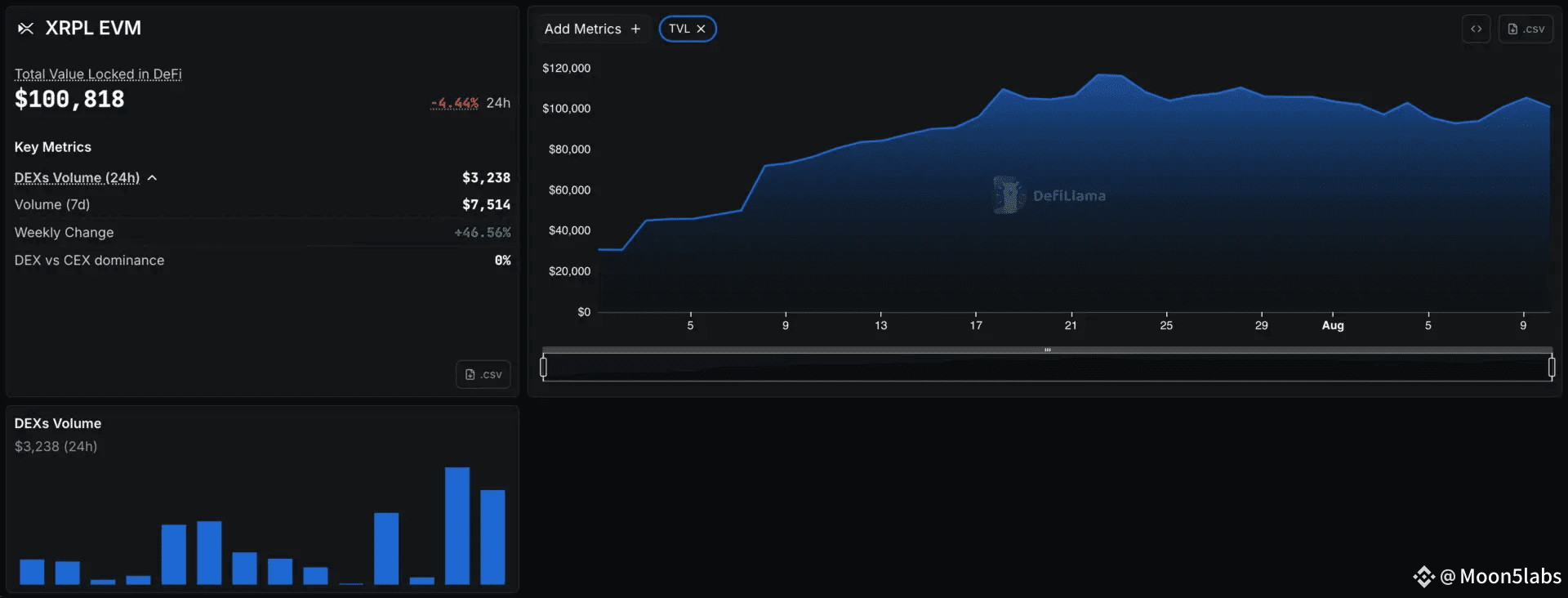The XRPL EVM sidechain, designed to bring Ethereum smart contract compatibility to the XRP Ledger ecosystem, is off to a weak start. According to the latest DeFiLlama data, the four chains built on the network have a total value locked (TVL) of just $100,818.
Currently, XRPL EVM hosts only three decentralized exchanges (DEXs) and one launchpad. Even worse, trading activity is almost nonexistent: over the past 24 hours, the entire trading volume ($3,238) came from Moai Finance. The remaining platforms — Riddle, XRiSE33 Network, and SurgeDefi — recorded zero trades during the same period.
Big Ambitions, Weak Reality
The project launched on June 30 with bold claims of ushering in a “new era of cross-chain DeFi.” Its goal was to attract Solidity developers to easily deploy EVM applications while leveraging XRPL’s long-standing stability and liquidity.
Reality tells a different story — the Developer Report shows XRPL EVM has only 168 active developers, compared to 8,448 on Ethereum — a staggering 98% gap. With low TVL and near-zero trading activity, the platform has yet to gain real traction.

RLUSD Stablecoin Also Lagging
Ripple’s RLUSD stablecoin has also failed to impress. Its market capitalization stands at $642 million, still below the $1 billion mark. Only $65.81 million (10.25%) of that is on XRPL, representing a mere 0.024% of the $271 billion stablecoin market.
By comparison, USDT has a market cap of $164 billion and USDC holds $65 billion.
Ripple’s Behind-the-Scenes Moves: Acquisitions, Politics, and Legislation
Ripple has been taking steps that might suggest it’s gearing up for expansion. It spent $200 million acquiring the stablecoin platform Rail. CEO Brad Garlinghouse testified before the U.S. Senate, calling for clear rules for digital assets and stablecoins.
In January, Garlinghouse and CLO Stuart Alderoty attended a private dinner with Donald Trump at Mar-a-Lago, calling it “a great start to 2025.” In March, Garlinghouse joined Trump’s crypto summit at the White House, praising the president’s vision of a “multichain world” and welcoming the inclusion of XRP in the proposed U.S. crypto reserve.
Political Wins and Legal Victories
Ripple secured a major legislative breakthrough in July when Trump signed the GENIUS Act — the first U.S. law on stablecoins. Alderoty attended the signing ceremony, calling the current administration “the most crypto-friendly we’ve ever seen.”
In August, Ripple scored a significant legal win when the SEC dropped its long-running lawsuit against the company, with Ripple agreeing to pay a $125 million fine.
But the Products Haven’t Caught On
Despite these political and legal victories, market reaction has been lukewarm. Neither the XRPL EVM sidechain nor the RLUSD stablecoin has managed to gain enough traction to spark broader adoption among users and investors.
#xrp , #Ripple , #XRPL , #RLUSD , #defi
Stay one step ahead – follow our profile and stay informed about everything important in the world of cryptocurrencies!
Notice:
,,The information and views presented in this article are intended solely for educational purposes and should not be taken as investment advice in any situation. The content of these pages should not be regarded as financial, investment, or any other form of advice. We caution that investing in cryptocurrencies can be risky and may lead to financial losses.“


